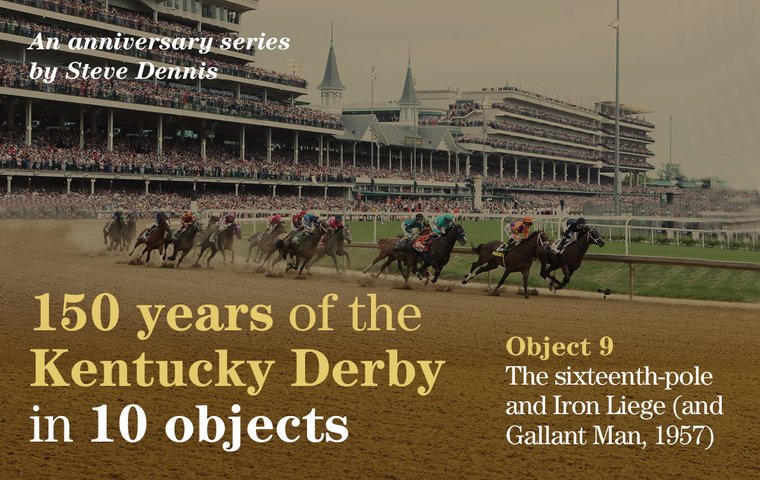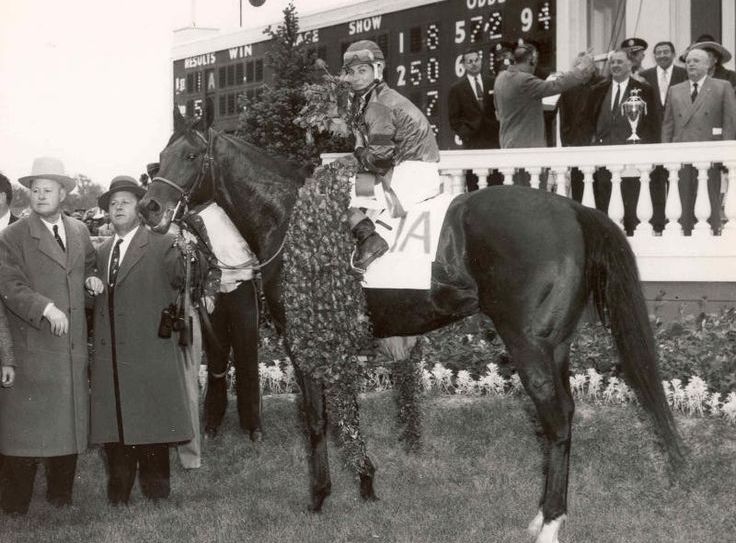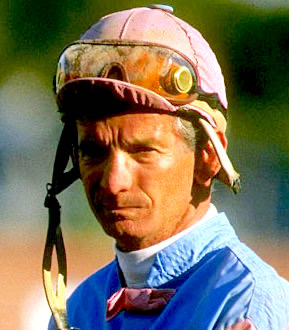
In the latest instalment of his series celebrating the 150th anniversary of the Kentucky Derby, Steve Dennis recalls a notorious blunder from a legendary figure
Everyone makes mistakes. To err is human, after all, and we can all think of a moment we’d like to take back, do differently. Bill Shoemaker certainly could.
 “If I could change anything, it would be missing that finish line on Gallant Man,” he told the New York Times decades later. “If you’re going to make a mistake, they say, make a big one.”
“If I could change anything, it would be missing that finish line on Gallant Man,” he told the New York Times decades later. “If you’re going to make a mistake, they say, make a big one.”
Oh, it was a big one. The 1957 Kentucky Derby had arguably the most accomplished field ever assembled for the Roses, and the finish was a thriller, but all anyone really remembers is Shoemaker’s blunder at the sixteenth-pole. One of the finest jockeys ever born won four Derbys, but the one he coulda won, shoulda won, didn’t win, followed him around like a dog for the rest of his Hall of Fame career.
Shoemaker was lucky even to be riding Gallant Man, called out of the bullpen when the colt’s regular jockey John Choquette was suspended for rough riding a week before the big race.
This change allowed for the application of another thick layer of lacquer to Derby legend, after Gallant Man’s owner Ralph Lowe told Shoemaker about a dream he’d had in which his horse was winning the Derby until Choquette misjudged the finish and lost the race.
“Mr Lowe, please don’t worry about that,” was the Shoe’s confident response. “I’m a professional rider. That won’t happen to me.”
If you say so, Willie.
The Derby-day drama began in the morning, when the favourite Gen. Duke was scratched with a bruised foot. That left Bold Ruler – runner-up to Gen. Duke in world-record time in the Florida Derby – as the heavy chalk against eight rivals including Gen. Duke’s barnmate Iron Liege, an 8-1 chance who had never won a stakes but had run third in that Florida Derby for trainer Jimmy Jones.
Titans of the sport
Gallant Man was second-choice after winning the Wood Memorial, while Round Table was strongly fancied after breaking the track record to win the Blue Grass. The top three on the tote board would become titans of the sport, all inducted into the Hall of Fame, yet none would be a Derby winner. The drama was not over, not by a long way.
The miler Federal Hill led the field as far as the top of the stretch before his tank emptied and Iron Liege went to the lead. As Bold Ruler began to fade, Shoemaker drove Gallant Man up to challenge Iron Liege. He was coming fast, half a length adrift, then a neck, then…
As the hard-pressed Iron Liege and the fast-closing Gallant Man passed the sixteenth-pole, Shoemaker inexplicably stood up in his stirrups, stopped his energetic drive for maybe one second, maybe two strides, interrupted the colt’s momentum. Lowe’s dream had come true.
 Shoemaker realised his error just as swiftly and set to work again, but the damage was beyond repair. Iron Liege had been given a vital reprieve and Bill Hartack – who was originally booked for Gen. Duke – didn’t let his second chance of a first Derby slip; Iron Liege was home by a nose.
Shoemaker realised his error just as swiftly and set to work again, but the damage was beyond repair. Iron Liege had been given a vital reprieve and Bill Hartack – who was originally booked for Gen. Duke – didn’t let his second chance of a first Derby slip; Iron Liege was home by a nose.
How much is a nose – an inch, two inches? How much ground had Shoemaker lost by mistaking the sixteenth-pole for the winning line and easing up – three inches, four?
A beleaguered Shoemaker first told the stewards that Gallant Man had stumbled, then told the truth, that he had misjudged the finish line. For the lie, the stewards gave him a 15-day suspension. The 15 days were soon up, but the truth would last a lifetime. Shoemaker had blown the Derby.
‘I blame the racetrack’
He had his defenders, but this defence was no form of attack. “I blame the racetrack,” said Gallant Man’s trainer, the great John Nerud, conveniently overlooking the fact that eight other jockeys knew where the line was.
“All the poles are the same colour,” added Nerud. “Willie rode a masterful race. What happened was more the track’s fault than Shoemaker’s.”
 Nerud wasn’t fooling anyone, least of all his jockey. The Shoe knew. Later, he opened the door of the confessional and unburdened himself.
Nerud wasn’t fooling anyone, least of all his jockey. The Shoe knew. Later, he opened the door of the confessional and unburdened himself.
“I hadn’t ridden at Churchill Downs in over a year,” he said. “I got the call to ride Gallant Man late and I had no other rides that day. And Churchill Downs is an unusual track. The sixteenth-pole is closer to the first turn than at any other track, so I began to raise up where the finish line normally is.”
That made as much sense as anything. Lowe, having lived his own nightmare, gave Shoemaker $5,000 and a new car to make him feel better about it, and in turn Shoemaker endowed the Ralph Lowe Award for sportsmanship in racing.
‘The word for that is class’
“Instead of hiding out and hoping people would forget his mistake, Shoe puts up his own money to remind people of it every year,” wrote Red Smith, the doyen of sports columnists. “The word for that is class.”
Class was the watchword of the 1957 Kentucky Derby. Pound-for-pound, as the boxing writers say, there has never been another Derby like it.
 Gallant Man moved on to win the Belmont (ridden by Shoemaker) by eight lengths in track-record time; third-placed Round Table won 43 of 66 races, became an outstanding champion on turf and the 1958 Horse of the Year; Bold Ruler, a weary fourth at Churchill Downs, rebounded to win the Preakness and was named 1957 Horse of the Year.
Gallant Man moved on to win the Belmont (ridden by Shoemaker) by eight lengths in track-record time; third-placed Round Table won 43 of 66 races, became an outstanding champion on turf and the 1958 Horse of the Year; Bold Ruler, a weary fourth at Churchill Downs, rebounded to win the Preakness and was named 1957 Horse of the Year.
Bill Shoemaker rebounded too. He retired in 1990 with a record 8,833 victories including those four Derbys, aboard Swaps (1955), Tomy Lee (1959), Lucky Debonair (1965) and, so memorably at the ancient age of 54, Ferdinand (1986). Yet, so goes the fisherman’s lament, the one on his mind was the one that got away.
In the winner’s circle, sunshine on his face and Ferdinand’s roses spilled redly over his lap, Shoemaker was asked whether the score was settled, the past at peace. He shook his head, remembering.
“No,” he said. “Nothing makes up for mistakes like that.”
• Visit the Kentucky Derby website and the Kentucky Derby Museum website
Citation: ‘He can catch and beat any horse he can see’ – when Calumet conquered all
‘He had materialised as if from nowhere’ – reliving the unlikely tale of Canonero II
‘The 2008 Kentucky Derby would shake racing’s complacency about its bad old habits until it cracked’
View the latest TRC Global Rankings for horses / jockeys / trainers / sires


